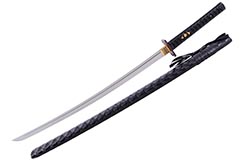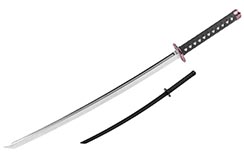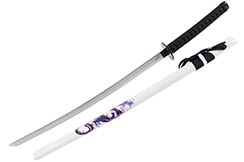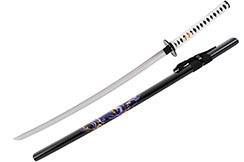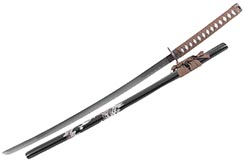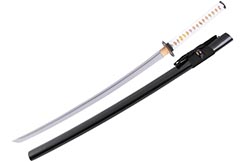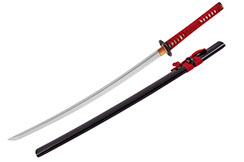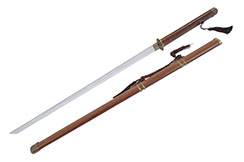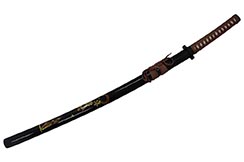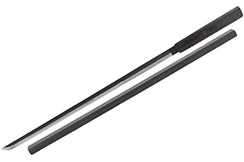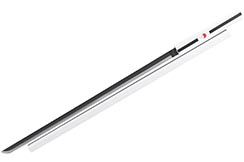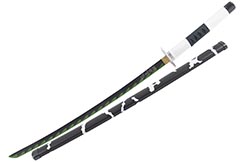- Discounts
- Return policy ?
-
 English
English
Product added (x)
Cart (0 products) Cart (1 product)
Katanas
We offer a selection of katanas forged in China in the best forges in Longquan, entirely handmade. We have top of the range models in laminated steel up to 7000 layers (Damascus steel), but also more affordable katanas with high carbon steel blades. You can also find wooden katanas for combat training. For aikido, kendo or yoseikan budo practitioners, get bokken, shinai and jyo from Dojo master, which offers excellent value for money.
Related categories
Katanas
What is a Katana?
A Katana is purely a longer saber (over 60cm).
Globally, the term Katana allows to encompass all Japanese sabers. However, the Katana remains THE Japanese saber by far.
Different types of katanas
Here are the differences between the most commonly used Japanese sabers :
- the katana: this is the standard Japanese sword.
- the iaito: this is a Japanese broadsword suitable for training. Indeed, it is a stainless steel or duralium weapon that is not sharpened, which allows an almost safe practice.
- the bokken (or boken): this is literally the wooden sword . In Japan, it is also called bokuto and is an ancient weapon renowned for its effectiveness as it was very deadly.
The Bokken is relatively long (around 1m) and the centre of gravity is usually in the first third of the weapon.
Bokkens should be made from hard, non-resinous woods such as white or red oak, ebony, medlar or yuzu.
A bokken is used for the practice of kenjutsu, aikido, kendo, iaido and jodo. - the suburito: this is a heavier bokken. It is very popular for solo kata and suburi.
- the shinai: this is a Japanese bamboo saber that is very popular in kendo. It is composed of 4 bamboo slats which have the effect of a whip. The shinai is very supple and not sharp, which makes it very popular for speed training.
- the wakizashi: also called shoto, is a very compact Japanese saber. It is a smaller weapon than a katana (length between 40 and 80cm) but was originally much more deadly.
Like the shinken, the wakizashi is a very sharp katana that is popular for close combat.
The wakizashi is used in the practice of kenjutsu and more particularly for the niten ryu style.
In the past, this weapon was used for much less glorious reasons. Indeed, it was the weapon of choice for ritual suicide. This ritual concerned samurai who had to cut themselves in the stomach. In some cases, an assistant was called in to cut off the samurai's head to wash away his sins. Historically, it was also the weapon used by merchants because they could not carry a katana (it was the weapon reserved for samurais). - the ninjato : hence the name, you will have understood the connection with ninjas!
- the shinken: it means "living blade". It is a katana known as a cutter (sharp blade).
It is a relatively paradoxical weapon because it must combine a hard and resistant edge with a flexible blade so as not to break.
Shinken are most often made of carbon steel, bent steel. The most noble material for this Japanese sword is tamahagane steel (a type of raw steel traditionally made with iron sand).
It is a weapon widely used in iaido and iaïjutsu.
Indeed, the ninjato was the weapon of choice for ninjas.
A little history is in order!
Initially, the ninjas used classic katanas, but carrying this weapon on their backs made it difficult for them to climb and to draw.
To improve these points, an evolution to a smaller model was necessary.
Unlike the wakizashi and the katana, which are weapons that emphasize cutting, the ninjato focuses on the balance of the guard and the handling (in this case with one hand).
Ninjato is still used in martial disciplines, for example in shinobi kenjutsu.
However, katanas (Japanese sabers) are as much weapons as works of art. These weapons symbolise power and honour, but they also represent the heritage of the Samurai and Japanese warriors.
How to use a Japanese saber?
The Katana is a weapon that is usually wielded with two hands due to its length and weight.
Typically, a katana weighs between 800g and 1.3kg. Although it is already difficult to handle 1 katana, there are techniques that require the use of two swords (one in each hand) which, in the long term, allow the acquisition of agility, dexterity and the dissociation of the movements of the right and left arms (practitioners are more likely to become ambidextrous).
Some generic terms to familiarise yourself with
- The Tsuka: This is the handle of the katana, it is always strung and the most traditional models are made of ray skin.
- The Tsuba: This is the guard of the katana, with the round and highly decorated shape.
- Ngasa: It is the blade of the katana, curved and with only one thread.
- The saya: The scabbard of the katana.
The katana, for which disciplines?
As noted above, different katanas are associated with different disciplines.
Don't worry, we'll give you a little reminder by discipline of the katanas you can use!
- Aïkido : bokken
- Batto do : shinken
- Iaido : iaito, bokken, shinken
- Iaijutsu : iaito, shinken
- Jodo : bokken
- Kata (solo) : shinai
- Kendo : bokken, shinai
- Kenjutsu : bokken, wakizashi
- Shinobi kenjutsu : ninjato
- Suburi : shinai
- Tameshigiri: shinken






